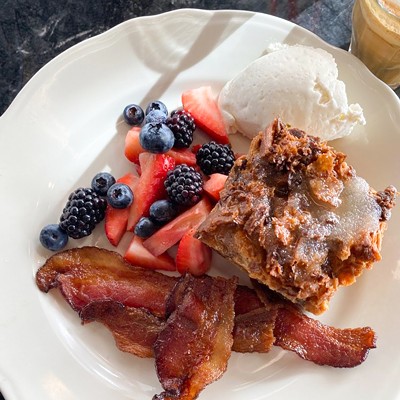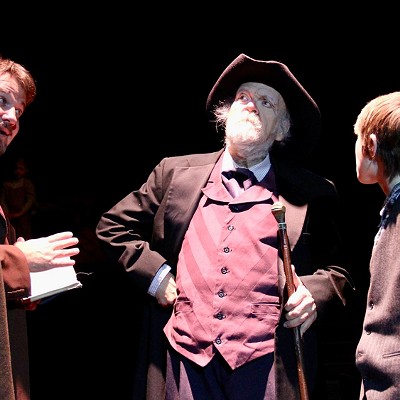It had been a days-long trip for the two Japanese macaques, rescued from a roadside zoo in upstate New York. Their journey finally had ended on the outskirts of Newcastle, at a remote location called Mindy’s Memory Primate Sanctuary.
Bob Ingersoll, the sanctuary's board president, greeted the monkeys.
“Hiya, buddies!” he said. “You’re about to be home.”
The macaques’ new residence is already home to nearly 100 other monkeys of varying species, each with their own temperament, personality and — usually — sad back story of how they ended up at Mindy’s Memory.
Visitors rarely are allowed inside the facility, and its caged inhabitants never leave the premises to visit a classroom or public event. Sanctuary Director Linda Barcklay keeps it all about the monkeys.
The place began to take shape about two decades ago. Barcklay’s McClain County home and pasture transformed into the unique haven after a small, underweight rhesus macaque suffering from health problems and abuse was donated to Barcklay in 1992.
Although the sanctuary started out only accepting pet monkeys that were no longer wanted, Barcklay now only takes rescued monkeys or those that have been subjected to testing in medical research labs.
“It just escalated,” said Barcklay. “I got calls from the research laboratories constantly. I’ve had to turn so many away because there’s no room. I have only so many acres, but every time we think there’s no more room, we build another cage.”
Pets and lab animals
Barcklay said the monkeys that were pets are usually more ill-tempered than those from labs, but that hardly means the latter have been well-treated.
“These [lab monkeys] have been handled a lot and whipped into submission,” she said. “There’s so much cruelty, it’s unimaginable. At least the pet people, they invest a lot of money; they want to find a home for their pet. The research people, their end is to kill it. They experiment on it until there’s nothing left. Then they kill it.”
Barcklay walked among dozens of large cages filled with chattering monkeys. A number bore the scars of experimentation. Some were missing nearly all their hair from lab testing. Others had their tails lopped off or teeth pulled.
right, Linda Barcklay operates Mindy's Memory Primate Sanctuary, a haven for abused and abandoned monkeys.
Barcklay stopped at a cage housing a macaque named Spock. The monkey stared at his visitors and yawned, revealing a set of vicious canines that once delivered a wound requiring 70 stitches on the leg of his former owner’s husband.
But captive animals such as monkeys can pose as much a danger to themselves as they do to humans.
“It’s very common in captive animals for self-mutilation,” Ingersoll said. “I’ve heard of monkeys that have bitten their penises off, practically bitten their arms off, bitten their hands off.”
For Barcklay and
Ingersoll, it is important to prevent the sanctuary from being perceived
as a zoo or to let the monkeys be presented as cuddly creatures that
would make nice pets.
“We
feel responsible for taking care of them the correct way, not to bring a
bunch of TV people and exploit them for a Cheerios commercial —
because, ultimately, that’s what that turns into,” Ingersoll said.
“Our
mission was never to educate the public by bringing animals to their
classrooms and all that stuff, which we tend to think is exploitation.”
But limited exposure to the outside world makes fundraising a challenge, Ingersoll said. Much of the sanctuary’s budget, he added,
comes from personal funds and anti-animal-experimentation organizations.
“Animals ought to be out there where they live and left alone,” Ingersoll said. “I don’t need my 8-year-old to touch an ocelot.”
Lawless territory
The
sanctuary operates under a paradox. The same lack of laws that enables
breeders to sell monkeys as pets or lab subjects also allows the
sanctuary to remain open.
“No
one knows what the rules are,” said Ingersoll, who was instrumental
decades ago in the rescue of a Norman-born chimpanzee whose story was
chronicled in a 2011 documentary film, “Project Nim.”
“There
are no rules. You can take a monkey, put it in a box, say it’s your
pet, and drive across state lines through almost every state with no
problem — as if it were a dog in a kennel — which is supremely
dangerous, and lame for the animal.”
Barcklay said she doubts the absence of regulation will be addressed anytime soon.
“As
long as there are breeders to supply the public with babies, it’s going
to continue,” she said. “Everybody’s tried [to remedy the problem]. The
[U.S. Department of Agriculture has] tried. The Humane Society has
tried.”
Sanctuary
Several people carefully released the two Japanese macaques into their new cage.
The three-person team
that rescued the monkeys, a Washington, D.C.-based group called Animal
Rescue Corps, had been contacted by Ingersoll to transport the monkeys
from New York to Oklahoma.
The
primates had been living in a long, three-walled structure exposed to
the outside with no heater, said Animal Rescue President Scotlund
Haisley. It wasn’t the worst environment the group had seen — they once
rescued a pair of primates from a house in Tennessee that contained a
meth lab — but it was far from good.
“Quite
honestly, they were not kept in anything like this,” Haisley said as he
checked out the macaques’ new cage. “This isn’t great, but this is as
good as it gets for a captive wild animal.”
The
team, dressed in quasi-paramilitary uniforms, took photos of the monkeys
as they came out of the animal carrier. The onlookers smiled
approvingly as the newest residents of Mindy’s Memory explored their new
habitat.
“This is the
good part,” Ingersoll said with a smile. “It’s pretty obvious that this
is a bad situation, but thank God for Linda.”
All photos by Mark Hancock. See more in the gallery below.











